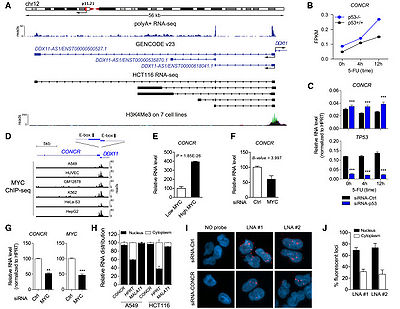DDX11-AS1
Contents
Annotated Information
Approved Symbol
DDX11-AS1 (DDX11 antisense RNA 1)
Synonyms
CONCR


Chromosome
12p11.21
RefSeq(supplied by NCBI)
NR_038927
Characteristics
DDX11-AS1 is a divergent non-overlapping transcript of the protein-coding gene DDX11, which is a predominant nuclear lncRNA. ChIP-seq data from ENCODE shows that MYC is bound to DDX11-AS1 promoter region in multiple cell types.
Expression
DDX11-AS1 is expressed in a panel of different human cell lines and upregulated in multiple cancer types. [1]
Regulated
DDX11-AS1 is negatively regulated by p53 and activated by MYC. [1]
Function
DDX11-AS1 contributes to tumor growth. [1] Expression of DDX11-AS1 is periodic in the cell cycle and its presence is required for efficient G1/S transition and DNA replication.[1] Depletion of DDX11-AS1 causes sister chromatid cohesion defects DDX11-AS1 interacts with DDX11 and regulates its function through enhancing the ATPase activity of DDX11.[1]
Labs working on this lncRNA
- Center for Applied Medical Research (CIMA), Department of Gene Therapy and Regulation of Gene Expression, University of Navarra, 55 Pio XII Avenue, 31008 Pamplona, Spain; Institute of Health Research of Navarra (IdiSNA), 31008 Pamplona, Spain. [1]
- Laboratory of Molecular Gerontology, National Institute on Aging, National Institutes of Health, NIH Biomedical Research Center, 251 Bayview Boulevard, Baltimore, MD 21224, USA. [1]
- Center for Applied Medical Research (CIMA), Department of Gene Therapy and Regulation of Gene Expression, University of Navarra, 55 Pio XII Avenue, 31008 Pamplona, Spain; Institute of Health Research of Navarra (IdiSNA), 31008 Pamplona, Spain. [1]